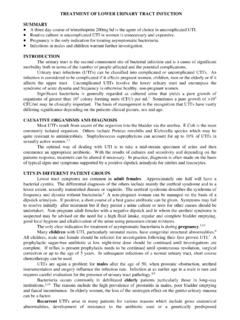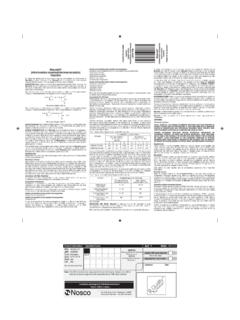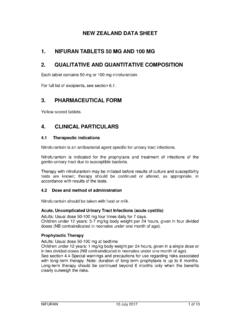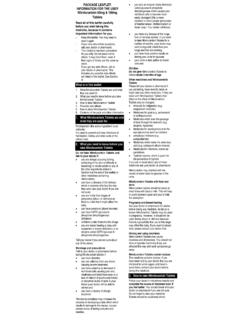Transcription of DRUGS FOR URINARY TRACT INFECTIONS (UTI Prepared by: …
1 DRUGS FOR URINARY TRACT INFECTIONS (UTI) Prepared by: Loren Regier Feb/051. Highlights Acute uncomplicated cystitis in otherwise healthy Short course - 3 day therapy suitable for cotrimoxazole ($10), trimethoprim & fluoroquinolones (~$20) nitrofurantoin ( Macrobid) a minimum of 7 days treatment is recommended. Fluoroquinolones have excellent activity against most URINARY pathogens; however concern that overuse is leading toincreasing antimicrobial resistance. Preserve them for those who really need them! Asymptomatic bacteriuria in the institutionalized elderly is common.
2 Antimicrobial treatment offers no benefit and increases the prevalence of resistant bacteria. Don t culture asymptomatic residents. 2. Oral Antimicrobials for URINARY TRACT InfectionsTrimethoprim/Sulfamethoxazole or Cotrimoxazole (SMX/TMP) {Alternately consider monotherapy with Trimethoprim}Coverage E. coli, P. mirabilis,. K. pneumonia, S. aureusAdverse effects diarrhea, rash, hematologic abnormalities (rare); (May use trimethoprim alone in sulpha allergic patients) (other less common effects: blood dyscrasias, diarrhea, pancreatitis, nephrotoxicity, urolithiasis, hepatotoxicity, hypersensitivity reactions, skin rash, toxic epidermal necrolysis & Stevens-Johnson syndrome.)
3 In patients with AIDS, cotrimoxazole produces an increased incidence of toxicity including a syndrome of fever, malaise, nausea and headache. Cotrimoxazole is also associated with disulfiram-like reactions. ) drug interactions cyclosporine cyclosp levels & nephrotoxicity, digoxin dig levels, methotrexate MTX toxicity, metronidazole disulfiram reaction, phenytoin phenytoin toxicity, sulfonylureas hypoglycemic effect, warfarin warf effectComments resistance is a problem especially in recurrent UTI; average reported resistance in SK is ~15%, however, higher in some institutional situations.
4 Other antibiotics should be used when resistance 20%. maintain hydrationNitrofurantoin{Macrobid 100mg BID: well tolerated and convenient}Coverage E. coli. K. pneumonia, S. aureus, Enterococcus faecalis; (not proteus, pseudomonas)Adverse effects rash, GI upset, increased LFTs; (other less common effects: pneumonitis and other pulmonary reactions, eosinophilia, hemolytic anemia, leukopenia, agranulocytosis, methemoglobinemia, peripheral neuropathy, pseudotumor cerebri, pseudomembranous colitis, nausea, vomiting, pancreatitis, parotitis, hepatitis, systemic lupus erythematosus and cutaneous and allergic reactions) drug Interactions Mg++ antacids absorption, norfloxacin norfloxacin effect.
5 Food s absorptionComments maintains excellent activity against E. coli, Enterococci, & Staph avoid in renal dysfunction (CrCl <50ml/min); limited tissue penetration; not useful in complicated UTIC iprofloxacin{Alternately, norfloxacin, gatifloxacin & levofloxacin; not moxifloxacin as lower concentration in urine}Coverage E. coli, P. mirabilis,. K. pneumonia, P. aeruginosa, +/- S. aureus (very broad coverage & effective agent)Adverse effects headache, GI upset; (Other less common effects: CNS side effects, including seizures; increases in transaminases and in some cases severe and fatal hepatitis have developed.)
6 Additionally, hematuria and anaphylactic reactions have been described) drug Interactions antacids absorption; may use a PPI / H2-antagonist; clozapine, glyburide hypoglycemia, iron cipro absorption, metoprolol metop level, phenytoin pheny levels, theophylline theoph toxicity, warfarin warf effect, zinc cipro absorption; 1A2 substrates inhibited by ciprofloxacin & levofloxacin effect of olanzapine, haloperidol, imipramine, cyclobenzaprine, fluvoxamine, other fluoroquinolones also effective; pseudomonal coverage with ciprofloxacin & norfloxacin. lower doses suitable for uncomplicated UTI; higher doses for complicated UTI & pyelonephritisAmoxicillin/Clavulinic Acid (Amox/Clav)Coverage E.
7 Coli, P. mirabilis, K. pneumonia, S. aureus, Enterococcus faecalisAdverse effects rash, GI upset (diarrhea, more with q8h dosing~25% formulations than with q12h formulations ~10%)(Other less common effects: eosinophilia, leukopenia and thrombocytosis; superinfections resulting in candidal vaginitis andpseudomembranous colitis may occur. Caution in patients with a sensitivity to penicillin.) drug Interactions oral contraceptives contraceptive effect, methotrexate MTX clearance & toxicity; Lab: false + ve Coomb s testComments good coverage for more resistant organisms including - single doseComments usually less effective than SMX/TMP , esp for S.
8 Saprophiticus; however E. Coli resistance uncommonNote: other beta-lactams (amoxicillin, 1st gen cephalosporins) are alternatives although generally less effective clinically than Urban Outpatient Susceptibility Patterns (SK) local susceptibility variation should be considered C&S results reflect patients with recurrent/more complicated INFECTIONS as these patients getting are cultured most frequently Frequency & susceptibility of pathogens found vary depending on inpatient vs outpatient and complicating factors Probable organisms: Acute Cystitis E. coli, S. saprophyticus; Complicated UTI E.
9 Coli, Enterococci, Klebsiella, Proteus, P. aeruginosa Pyelonephritis E. coli, Klebsiella, Enterobacter, Proteus mirabillis; Prostatitis E. coli, Gm ve bacilli, Staph, enterococcus E. coli (most common uropathogen): 83-87% S to SMX/TMP; 99% S to NTF; 94% S to Cipr; 82% S to Amox/Clav Enterococcus: Resistant to SMX/TMP 99% S to NTF; 74% S to Cipr; 98% S to Amp References: 1. Anti-infective Review Panel. Anti-infective Guidelines for Community-acquired INFECTIONS 2005, Toronto, ON (Canada). 1. Sanford Guide to Antimicrobial Therapy Bugs and DRUGS , 4.
10 Micromedex 2004 drug database. 5. Walker S, et al. Why are antibiotics prescribed for asymtomatic bacteriuria in institutionalized elderly people?CMAJ 2000;163:273-7. 6. Nicolle L. Empirical treatment of acute cystitis in women. Int J Antimicrob Agents 2003;22:1-6. 7. Lummus W, Thompson I. Prostatitis. Emerg Med Clin N America2001;19:691-707. 8. Warren J, et al. Guidelines for antimicrobial therapy of uncomplicated acute bacterial cystitis and acute pyelonephritis in women. Clin Infect Dis 1999;29:745-58. 9. Miller L,Treatment of Uncomplicated URINARY TRACT INFECTIONS in an Era of Increasing antimicrobial Resistance.





